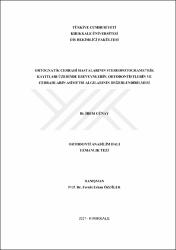| dc.contributor.advisor | Özdiler, Ferabi Erhan | |
| dc.contributor.author | Günay, İrem | |
| dc.date.accessioned | 2021-01-16T19:13:08Z | |
| dc.date.available | 2021-01-16T19:13:08Z | |
| dc.date.issued | 2017 | |
| dc.identifier.uri | | |
| dc.identifier.uri | https://hdl.handle.net/20.500.12587/17178 | |
| dc.description | YÖK Tez ID: 460405 | en_US |
| dc.description.abstract | Bu çalışmanın amacı, ortognatik cerrahi hastalarında ve anne-babalarında yüz asimetrisi varlığını tespit etmek ve ebeveynlerin, ortodontistlerin ve ağız, diş ve çene cerrahlarının asimetri algılarını ve bu algının mirror uygulaması ile değişimini araştırmaktır. Çalışma, İnönü Üniversitesi Diş Hekimliği Fakültesi, Ortodonti Anabilim Dalı' na tedavi için başvuran 35 hasta (16 erkek, 19 kadın, yaş ortalaması 18 ± 1.5 yıl) ve ebeveynleri olmak üzere toplam 105 kişi üzerinde gerçekleştirilmiştir. Üç boyutlu yüz görüntüleri 3dMD vultus (3dMD TM, Atlanta, GA, ABD) yazılımı kullanılarak işlenmiş ve analiz edilmiştir. Ayna görüntülerini oluşturmak için midsagital düzlem belirlenmiştir. Gerçek yüz görüntüsünden, tespit edilen midsagital düzlem kullanılarak sağ tam yüz ve sol tam yüz olacak şekilde iki yeni yüz görüntüsü elde edilmiştir. RMS sapması (asimetri derecesi) tüm yüz ve alt yüz için 3dMD vultus yazılımının yüzey süperpozisyon özelliğini kullanarak ölçülmüştür. Ek olarak, ebeveynler, ortodontistler, oral ve maksillofasiyal cerrahlar tarafından hastaların ilk ve ayna görüntüleri üzerine VAS (görsel analog skala) kullanılarak nitel değerlendirme yapılmıştır. Değişkenlerin normal dağılımdan gelme durumları araştırılırken birim sayıları nedeniyle Shapiro Wilk's'den yararlanılmıştır. Yüz asimetrisini değerlendirmek için parametrik olmayan Kruskal-Wallis testi kullanılmıştır. İstatistiksel anlamlılık düzeyi olarak p<0,05 belirlenmiştir. RMS sapması verileri hastalarda 1,11, annelerde 1,38, babalarda ise 1,40 olarak bulunmuştur. Çalışmamızda elde edilen VAS bulgularına göre en yüksek skorlar ortodonti öğretim üyelerine aitken ve sonrasında sırasıyla ağız diş ve çene cerrahları, ortodonti asistanları, babalar ve anneler şeklinde sıralanmıştır. Anneler, diğer gruplara göre çocuklarının yüzlerini istatistiksel olarak anlamlı derecede daha simetrik olarak değerlendirmişlerdir. Bu çalışmada ortognatik cerrahiye ihtiyaç duyan hasta grubunda yüz asimetrisi varlığı kantitatif olarak tespit edilmiştir. Üç boyutlu yumuşak doku analizi, ebeveynlerin yüzlerinin çocuklarından daha asimetrik olduğunu göstermiştir. Mirror uygulaması yüz asimetrisi algısını artıran bir yöntemdir. | en_US |
| dc.description.abstract | The aim of this study is to evaluate facial asymmetry in orthognatic surgery patients and their parents and asymmetry perceptions of parents, orthodontists and oral and maxillofacial surgeons, to investigate the change of the asymmetry perceptions with mirror application. The study was carried out on a total of 105 individuals, 35 patients (16 males, 19 females, mean age 18 ± 1.5 years) and their parents who applied to İnönü University Faculty of Dentistry, Orthodontics Department for treatment. Three dimensional facial images were processed and analyzed using 3dMD vultus (3dMD TM, Atlanta, GA, USA) software. The midsagittal plane was determined to create mirror images. Original face divided into 2 part using established midsagittal plane and 2 total faces generated, one with a right total face and the other left total face. The RMS deviation (asymmetry grade) was measured using the surface superposition feature of the 3dMD vultus software for the entire face and bottom face. In addition, parents, orthodontists, oral and maxillofacial surgeons performed qualitative assessment of patients' first and mirror images using VAS (visual analogue scale). While the normal distribution of variables was investigated, Shapiro Wilk's test was used because of the number of units. Non-parametric Kruskal-Wallis tests were used for data analysis to assess facial asymmetry. A p value of less than 0,05 was considered as statistically significant. RMS deviation was found to be 1.11 in patients, 1.38 in mothers and 1.40 in fathers. According to the findings of VAS obtained in our study, the highest scores belonged to orthodontists, followed by oral and dental surgeons, orthodontics phd. students, fathers of the patients and mothers respectively. Asymmetry scores of the mothers are minimum among all groups and the difference was statistically significant. In this study, the presence of facial asymmetry was quantitatively determined in the patient group who needed orthognathic surgery. Three-dimensional soft tissue analysis has shown that the faces of the parents are more asymmetrical than their children. Mirror application is a method that increases the perception of facial asymmetry. | en_US |
| dc.language.iso | tur | en_US |
| dc.publisher | Kırıkkale Üniversitesi | en_US |
| dc.rights | info:eu-repo/semantics/openAccess | en_US |
| dc.subject | Diş Hekimliği | en_US |
| dc.subject | Dentistry | en_US |
| dc.title | Ortognatik cerrahi hastalarının stereofotogrametrik kayıtları üzerinde ebeveynlerin, ortodontistlerin ve cerrahların asimetri algılarının değerlendirilmesi | en_US |
| dc.title.alternative | Evaluation of asymmetry perceptions of parents, orthodontists and surgeons on stereophotogrammetric records of orthognathic surgical patients | en_US |
| dc.type | specialistThesis | en_US |
| dc.contributor.department | KKÜ, Diş Hekimliği Fakültesi, Ortodonti Anabilim Dalı | en_US |
| dc.identifier.startpage | 1 | en_US |
| dc.identifier.endpage | 131 | en_US |
| dc.relation.publicationcategory | Tez | en_US |
















